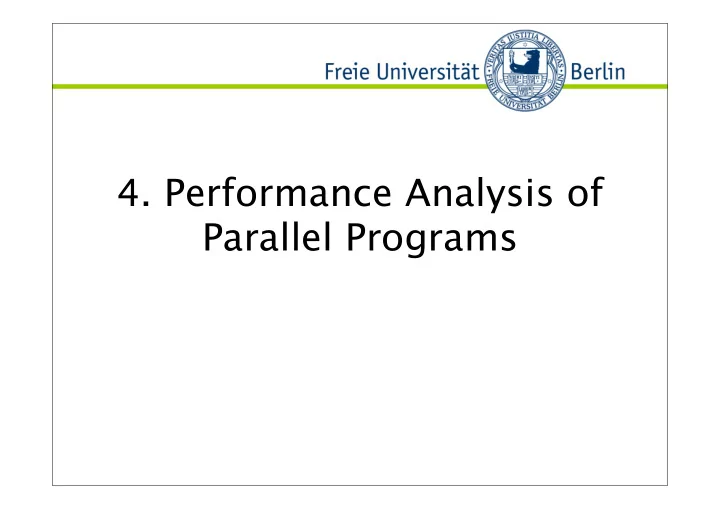

4. Performance Analysis of Parallel Programs
4.1 Performance Evaluation of Computer User criteria: - Small response times Computing center criteria: - High throughputs
4.1.1 Evaluation of CPU Performance
4.1.1 Evaluation of CPU Performance The response time of a program A can be split into:
4.1.1 Evaluation of CPU Performance The response time of a program A can be split into: User CPU time of A
4.1.1 Evaluation of CPU Performance The response time of a program A can be split into: User CPU time of A System CPU time of A
4.1.1 Evaluation of CPU Performance The response time of a program A can be split into: User CPU time of A System CPU time of A Waiting time of A
4.1.1 Evaluation of CPU Performance The response time of a program A can be split into: User CPU time of A System CPU time of A Waiting time of A
4.1.1 Evaluation of CPU Performance User CPU time of A
4.1.1 Evaluation of CPU Performance User CPU time of A t cycle -> reciprocal to clock rate: T=1/f -> 2GHz = 1/(2*10 9 )s = 0.5ns (cycle time) n cycle (A)-> total number of CPU cycles needed for all instructions of A
4.1.1 Evaluation of CPU Performance CPI ( C lock cycles P er I nstruction)
4.1.1 Evaluation of CPU Performance CPI ( C lock cycles P er I nstruction)
4.1.1 Evaluation of CPU Performance CPI ( C lock cycles P er I nstruction) n instr (A) -> total number of instructions executed for A
4.1.1 Evaluation of CPU Performance CPI ( C lock cycles P er I nstruction) n i (A) -> is the number of instructions of type I i executed for the program A CPI i -> number of CPU cycles needed for instructions of type I i
4.1.1 Evaluation of CPU Performance CPI ( C lock cycles P er I nstruction) Example: We consider a processor with three instruction classes I 1 , I 2 , I 3 containing instructions which require 1, 2, or 3 cycles for their execution. We assume that there are two di fg erent possibilities for the translation of a Programming language construct using di fg erent instructions. CPI 1 = 10/5 = 2 CPI 2 = 9/6 = 1,5
4.1.2 MIPS and MFLOPS
4.1.2 MIPS and MFLOPS MIPS ( M illion I nstructions P er S econd)
4.1.2 MIPS and MFLOPS MIPS ( M illion I nstructions P er S econd) Drawbacks/limitations: - Only considers the number of instructions. - MIPS rate does not necessarily correspond to the execution time.
4.1.2 MIPS and MFLOPS MFLOPS ( M illion F loating-point O perations P er S econd)
4.1.2 MIPS and MFLOPS MFLOPS ( M illion F loating-point O perations P er S econd)
4.1.2 MIPS and MFLOPS MFLOPS ( M illion F loating-point O perations P er S econd) Drawbacks/limitations: - Doesn’t di fg erence between types of floating-points operations performed.
4.1.3 Performance of Processors with a Memory
4.1.3 Performance of Processors with a Memory
4.1.3 Performance of Processors with a Memory n mm_cycles (A) -> number of additional machine cycles caused by memory accesses of A .
Recommend
More recommend